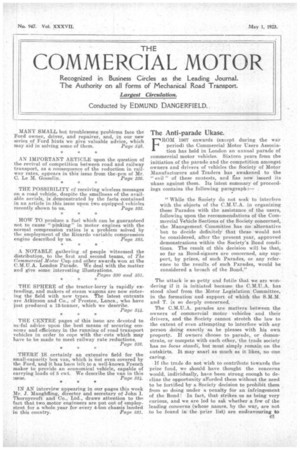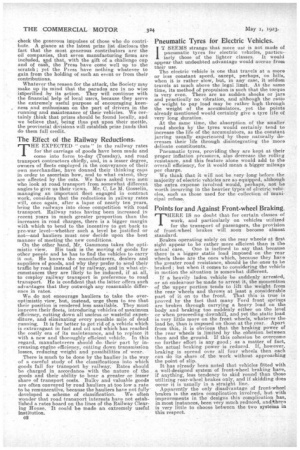The Anti-parade Ukase.
Page 1

Page 2

If you've noticed an error in this article please click here to report it so we can fix it.
FROM 1907 onwards (except during the war period) the Commercial Motor Users Association has held in London an annual parade of commercial motor vehicles. Sixteen years from the initiation of the parade and the competition amongst owners and drivers of vehicles the Society of Motor Manufacturers and Traders has awakened to the " evil" of these contests, and Cias now issued its ukase against them. Its latest summary of proceedings contains the following paragraph:— " While the Society do not seek to interfere with the objects of the C.M.U.A. in organizing these Parades with the assistance of the users, following upon the recommendations of the Commercial 'Vehicle Sections of the Society concerned, the Management Committee has no alternative but to decide definitely that these would not he considered, after the present year, approved demonstrations within the Society's Bond conditions. The result of this decision will be that, SO far as Bond-signers are concerned, any support, by prizes, of such Parades, or any reference to the results of such Parades, would be considered a breach of the Bond."
The attack is so petty and futile that we are wondering if it is initiated because the C.M.U.A. has stood aloof from the Motor Legislation Committee, in the formation and support of which the S.M.M. and T. is so deeply concerned.
The C.M.U.A. parades are matters between the owners of commercial motor vehicles and their drivers, and the Society cannot stretch the law to the extent of even attempting to interfere with any person doing exactly .as he pleases with his own property. If owners choose to parade, or demonstrate, or compete with each other, the trade society has no locus seandi, but must simply remain on the outskirts. It may snarl as much as it likes, no one caring.
If the trade do not wish to contribute towards the prize fund, we should have thought the concerns would, individually, have been strong enough to decline the opportunity afforded them without the need to be fortified by a Society decision to prohibit them from so doing under a penalty for an infringement of the Bond I In fact, that strikes us as being very curious, and we are led to ask whether a few of the leading concerns (whose names, by the way, are net to be found in the prize list) are endeavouring to
check the generous impulses of those who do contribute. A glance at the latest prize list discloses the fact that the most generous contributors are the oil companies, that seven manufacturing firms are included, and that, with the gift of a challenge cup and of cash, the Press have come well up to the scratch ; yet the Pi ess have nothing whatever to gain from the holding of such an event or from their contributions.
Whatever the reason for the attack, the Society may make up its mind that the parades are in no wise intperilled by its action. They -will continue with the financial help of local users, because they serve the extremely useful purpose of encouraging keenness and enthusiasm on the part of drivers in the running and maintenance of their vehicles. We certainly think that prizes should be found locally, and we believe that, being thus put upon their mettle, the provincial divisions will establish prize funds that do them full credit. .
The Effect of the Railway Reductions.
THE EXPECTED " cuts " in the railway rates for the carriage of goods have been made and come into force to-day (Tuesday), and road transport contractors chiefly, and, in a lesser degree, owners of fleets employed in the conveyance of their
own merchandise, have donned their thinking caps in order to ascertain how, and to what extent, they are affected by the cuts. We have asked two men who look at road transport from somewhat different angles to give us their views. Mr. C. Le M. Gosselin, managing an important fleet engaged in contract work, considers that the reductions in railway rates will, once again, after a lapse of nearly ten years, bring the railways into close competition with road transport. Railway rates having been increased in recent years in much greater proportion than the increases in road charges, there is a bigger margin with which to bend to the incentive to get back to pre-war level—whether such a level be justified or not—and hauliers must now decide upon the best manner of meeting the new conditions. On the other hand, Mr. Gammons takes the optimistic view. His task is the moving of goods for other people and he has to find the vehicles to carry it out. He knows the manufacturers, dealers and suppliers of goods, and why they prefer to send their traffic by road instead of by railway, and in what circumstances they are likely to be induced, if at all, to employ railway transport in preference to road transport. He is confident that the latter offers such advantages that they outweigh any reasonable difference in rat.
We do not encourage hauliers to take the overoptimistic view, but, instead, urge them to see that their position is rendered less assailable. They must improve their fleets, introducing vehicles of maximum efficiency, cutting down all useless or wasteful expen diture, and eliminating every possible mile of dead running. It is far better to get rid of a vehicle which is extravagant in fuel and oil and which has reached the costly era of its maintenance, and to replace it with a new and thoroughly efficient vehicle. In this regard, manufactnrers should do their part by increasing. engine efficiency, cutting down transmission losses, reducing weight and possibilities of wear.
There is much to be done by the haulier in the way of a careful study of the classifications into which goods fall for transport by railway. Rates should be charged in accordance with the nature of the goods and their ability to bear a greater or lesser share of transport costs. Bulky and valuable goods are often conveyed by road hauliers at too low a rate to be remunerative, because the hauliers have not fully developed a scheme of classification. We often wonder that road transport interests have not established a rates board on the lines of the Railway Clearing House. It could be made an extremely useful institution.
02
Pneumatic Tyres for Electric Vehicles.
IT SEEMS strange that more use is not made of pneumatic tyres foe electric vehicles, particu
larly those of the lighter classes. It would appear that undoubted advantage would accrue from. their use.
The electric vehicle is one that travels at a more or less constant speed, except, perhaps, on hills, when it is rather slow, but, in any case, it seldom travels at much above the legal limit. At the same time, its method of propulsion is such that the torque is very even. There are no sudden shocks or jars and practically no vibration, and although the ratio of weight to pay load may be rather high through the weight of the accumulators, yet the points already mentioned would certainly give a tyre life of very long duration.
At the Same time, the absorption of the smaller road shocks by the tyres would certainly tend to increase the life of the accumulators, as the constant jarring usually experienced by these naturally aecreases their life through disintegrating the more delicate constituents.
Pneumatic tyres, providing they are kept at their proper inflation pressures, also decrease the rolling resistance, and this feature alone would add to the overall efficiency, for it would mean a bigger mileage per charge.
We think that it will not be very long before the majority of electric vehicles are so equipped, although the extra expense involved would, perhaps, not be worth incurring in the heavier types of electric vehicles, such as those used for the collection of 'municipal refuse.
Points forand Against Front-wheel Braking. Points forand Against Front-wheel Braking.
THERE IS no doubt that for certain classes of work, and particularly on vehicles utilized for the transport of passengers the provision of front-wheel brakes will soon become almost standard.
Brakes operating solely on the rear wheel S at first sight appear to be rather more efficient than is the actual case. One is inclined to say that because there is a bigger static load imposed on the rear wheels these are the ones which, because they have the greater road resistance, should be the ones to be braked ; but when it comes to considering the vehicle in motion the situation is somewhat different.
If a heavily laden vehicle be suddenly arrested, or an endeavour be made to arrest it, the momentum of the upper portion tends to lift the weight from the rear 'wheels and throws at least a considerable part of it on to the front. That this is true is proved by the fact that many Ford front springs are broken through carrying a heavy load on the body and braking too suddenly either on the level or when proceeding downhill, and yet the static load is very little more on the front wheels, whatever the load be, than is imposed on those at the re„ar. Apart from this, it is obvious that the braking power of the rear wheels is limited by the cohesion between them and the ground. If this cohesion be overcome no further effort is any good ; as a matter of fact, the actual braking power is reduced. If, however. braking is spread over all four wheels then each can do its share of the work without approaching the point of slip. It has already been noted that vehicles fitted with a well-designed system of front-wheel braking have, if anything, less tendency to skid round than those utilizing rear-wheel brakes only, and if skidding does occur it is usually in a straight line. Apparently the only disadvantage of front-wheel brakes is the extra complication involved, but with improvements in the designs this complication has, in most instances, been very much reduced, and ?there is very little to choose between the two systems in this respect.
































